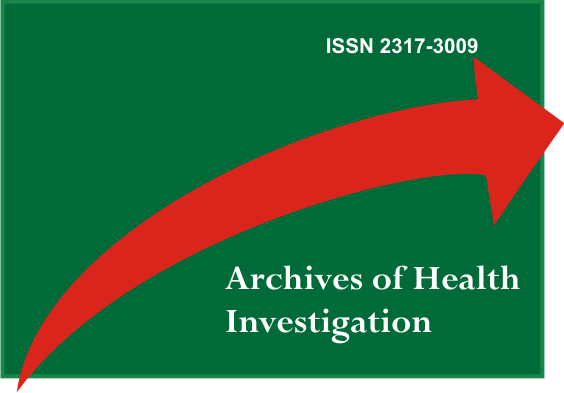Invasive basal cell carcinoma: A case report
DOI:
https://doi.org/10.21270/archi.v7i3.2809Resumo
Basal cell carcinoma (BCC) is an epithelial tumor of low-grade malignancy, recurrent, with capacity for local invasion and destruction of adjacent bone or cartilage, yet rare metastasis. It presents as superficial, fibro-epithelial, nodular, sclerosing or pigmented. The best treatment is surgical excision; and frequently the cancer has a good prognosis. The purpose of this article is to study and discuss the clinical, histopathological and treatment of BCC.Descriptors: Maxillofacial Abnormalities; Neoplasms; Carcinoma, Basal Cell; Diagnosis; Therapeutics.
Downloads
Referências
Martín-Gorgojo A, Pastushenko I. New Perspectives in the Management of Basal Cell Carcinoma. Actas Dermosifiliogr. 2014; 105(9):874-5.
Chinem VP, Miot HA. Epidemiologia do carcinoma basocelular. An bras dermatol. 2011; 86(2): 292-305.
Totonchy M, Leffell D. Emerging concepts and recent advances in basal cell carcinoma. F1000Res. 2017; 6 (2085).
Kedilioglu MA, Bos PG, De Jong K, Noordzij NA, Kibbelaar RE, Lapid O et al. Whole specimen intraoperative frozen section analysis. Experience with 1082 basal cell carcinomas. Eur J Surg Oncol. 2017; 44(1):157-62.
Lopes Filho, LL, Lopes LRS, Neto ABV, Costa TS . Carcinoma basocelular no lábio superior: tratamento cirúrgico e reconstrução com retalho de transposição. Surg Cosmet Dermatol. 2011;3(3):243-5.
Devine C, Srinivasan B, Sayan A, Ilankovan V. Epidemiology of basal cell carcinoma: a 10-year comparative study. Br J Oral Maxillofac Surg.2017; S0266-4356(17):30746-5.
Paolino G, Donati M, Didona D, Mercuri SR, Cantisani C. Histology of Non-Melanoma Skin Cancers: An Update. Biomedicines. 2017; 5(4)pii:E71.
Clark, CM, Furniss M, Mackay-Wiggan JM. Basal Cell Carcinoma: An Evidence-Based Treatment Update. Am J Clin Dermatol. 2014; 15(3):197-216.
Themstrup L, De Carvalho N, Nielsen SM, Olsen J, Ciardo S, Schuh S et al. In vivo differentiation of common basal cell carcinoma subtypes by microvascular and structural imaging using dynamic optical coherence tomography. Exp Dermatol. 2018; 27(2):156-65.
Toosi AB, Roshan NM, Ghoncheh M. Evaluation of subclinical extension of basal cell carcinoma. World J Plast Surg.2017; 6(3):298-304.
Cajina-Vázquez A. Carcinoma basocelular. Rev Med de Costa Rica y Centroamérica. 2012; Lxix(603): 325-9.
Rodríguez RG, Cossío PI, Parejo PR, Carranza ET, García AGP, Castro DS. Síndrome de Gorlin-Goltz: manejo del carcinoma basocelular facial. Rev Esp Cir Oral Y Maxilofac. 2013; 35(1):23-30.
Lewin JM, Carucci JA. Advances in the management of basal cell carcinoma. F1000Prime Reports. 2015;7(53).
Sari E. Non-metastatic Non-melanoma Skin Cancers: Our 3 years of clinical experiences. World J Plast Surg. 2017; 6(3), 305-12.
Campos ECR, Simões JC, Kamei DJ, Santos FMR, Pinheiro EB A, Baldissera RL. Análise do perfil epidemiológico, clínico e patológico de pacientes portadores de câncer de pele não melanoma tratados no Hospital Universitário Evangélico de Curitiba. Rev Med Resident. 2011; 13(4):251-60.
Nasser N. Epidemiologia dos carcinomas basocelulares em Blumenau, SC, Brasil, de 1980 a 1999. An. Bras. Dermatol. 2005; 80(4): 363-8.
Brasil. Instituto Nacional de Câncer. Prevenção e controle do câncer: normas e recomendações do INCA. Rev. Bras. Cancerol. (Online). 2002; 48(3):317-32.


